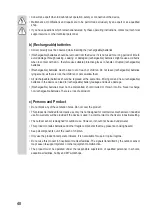
47
b) Tips for safe installation
Metal objects and the tops of tall buildings are susceptible to lightning strikes. Never install the outdoor
sensor during storms. Wait for a dry day with good weather.
Use fall protection equipment such as a safety harness and a net in the following scenarios:
- When you are working on/above water or other areas into which you may sink in the event of a fall
(e.g. a pond), regardless of your height above the ground
- Above 1 m: When you are working on a stable surface, staircases/landings and wall openings.
- Above 3 m: When you are working on a roof.
- All other surfaces that are more than 2 m above the ground.
•
Secure any holes in floors, ceilings and roofs with protective equipment for the entire duration of the
installation process.
• Secure materials and tools to the surface to prevent them from falling off.
• The area below the installation surface must be cordoned off when you are working.
• Mark the hazardous area below the installation surface with warning signs such as "Warning, roof work
in progress", or close off the area to unauthorized personnel.
• If you are mounting the outdoor sensor in an elevated position, secure it with a separate device in
addition to the mounting mast.
Ensure that no existing cables or pipes (including water pipes) are damaged when drilling mounting holes
or securing screws.
9. Setting up and mounting
a) Weather station
The weather station can be stood on a level indoor surface using the fold-out stand (20). A suitable mat should be
used to prevent scratch marks on furniture. Alternatively, the weather station can be hung onto wall-mounted screws
using the hanging holes (11).
To ensure optimal reception, the weather station should not be placed next to other electronic devices,
cables or metal objects. The weather station and outdoor sensor should be at least 2 m away from sources
of interference. Obstacles that impair communication between the two devices (e.g. buildings) should also
be avoided. The maximum range of the wireless signal is approximately 100 m. This decreases when
obstacles are present.
















































